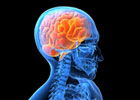 As UHN's monthly research newsletter, NRx reports on the full spectrum of leading research from UHN's five research institutes. Located in downtown Toronto, these institutes are the Princess Margaret (PM) Cancer Centre, the Toronto General Research Institute (TGRI), the Toronto Western Research Institute (TWRI), the Toronto Rehabilitation Institute (TRI) and the Techna Institute (Techna).
As UHN's monthly research newsletter, NRx reports on the full spectrum of leading research from UHN's five research institutes. Located in downtown Toronto, these institutes are the Princess Margaret (PM) Cancer Centre, the Toronto General Research Institute (TGRI), the Toronto Western Research Institute (TWRI), the Toronto Rehabilitation Institute (TRI) and the Techna Institute (Techna).
In this issue you can read about:
- A link between a type of arthritis and hardening of the arteries
- A new way to target tumour tissue
- The need for new stroke rehabilitation approaches
- Brain imaging as a measure of Parkinson's disease progression
- How certain signals from the brain may prevent type 2 diabetes
- UHN's newest facility: the Vector Core
We hope that you will find NRx informative. If you have feedback or questions, please contact www@uhnresearch.ca.
Christopher J. Paige, PhD, FCAHS
Vice President, Research
University Health Network

In psoriatic arthritis, the symptoms of arthritis (joint pain, swelling and stiffness) are accompanied by distinctive skin lesions known as psoriasis.
Patients diagnosed with a psoriatic arthritis (PsA) are at a greater risk of developing cardiovascular complications, such as heart attacks and strokes. This may be explained by the fact that PsA patients are more prone to atherosclerosis, a process in which the walls of arteries thicken and lose their elasticity. It is unclear this is the case.
A new study by TWRI Senior Scientist Dr. Dafna Gladman reveals, for the first time, that the inflammation that causes joint pain and swelling in arthritis might also promote atherosclerosis in patients with PsA. The clinical study was carried out by Dr. Lihi Eder, a postdoctoral fellow with Dr. Gladman. Dr. Eder enrolled 235 patients with PsA who were subjected to a physical examination and a battery of laboratory tests to assess the severity of their arthritis, inflammation and atherosclerosis and to identify other risk factors for cardiovascular disease (eg, obesity, smoking, diabetes and high blood pressure). The researchers found that an increased burden of inflammation over time and the presence of cardiovascular risk factors were associated with more severe atherosclerosis.
These findings suggest that anti-inflammatory drugs could potentially be used to prevent the progression of atherosclerosis and decrease the cardiovascular complications that occur in PsA patients.
This work was supported by a grant from AbbVie Canada. The Psoriatic Arthritis Research Program is supported by the Krembil Foundation, the Toronto General & Western Hospital Foundation and the Arthritis Research Foundation.
Increased burden of inflammation over time is associated with the extent of atherosclerotic plaques in patients with psoriatic arthritis. Eder L, Thavaneswaran A, Chandran V, Cook R, Gladman DD. Annals of the Rheumatic Diseases. 2014 May 14. [Pubmed abstract]

A specific receptor on many cancer cells ushers in the HPPS nanoparticle and its therapeutic payload, like Trojans welcoming the mythical horse.
RNA interference is a powerful technique for fighting cancer that can selectively block the actions of disease-related genes. However, turning RNA interference technology into a viable treatment is a significant challenge as the active component—silencing RNA (siRNA)—is rapidly degraded or removed from the bloodstream after injection. Techna Team Lead and PM Senior Scientist Dr. Gang Zheng has created a small carrier molecule known as HPPS that serves as a Trojan horse to protect and transport the siRNA through the bloodstream to the tumour.
Dr. Zheng and his team tested the major benefits of this nanoparticle: it can be tracked and quantified with near-infrared light; it is non-toxic; it can contain different kinds of siRNAs; and most importantly, it can attach to cancer cells and get pulled directly inside the cell, where its siRNA payload can be delivered for maximum effect.
Because the HPPS molecule can be tracked non-invasively, the scientists were able to measure how much of the siRNA was delivered to the tumour. "Nanoparticles like this, with diagnostic imaging and therapeutic capabilities—known as 'theranostics'—represent the future of drug delivery. These will help us to monitor how we target tumour tissue and to optimize treatment plans and dosages," says Dr. Zheng.
This work was supported by the Canadian Institutes of Health Research, the Canadian Diabetes Association, the Canada Foundation for Innovation, the Ontario Ministry of Research and Innovation, and The PM Cancer Foundation.
Nanoparticle-enabled, image-guided treatment planning of target specific RNAi therapeutics in an orthotopic prostate cancer model. Lin Q, Jin CS, Huang H, Ding L, Zhang Z, Chen J, Zheng G. Small. 2014 April 6. [Pubmed abstract]

80% of stroke survivors suffer from hemiparesis, which is a weakness or inability to move one side of their body.
For those recovering from a stroke, the ability to walk using each side of the body equally (ie, symmetrically) can be a challenge. This is because one of the most common stroke-related impairments is partial paralysis on one side of the body. While rehabilitation approaches exist that aim to restore symmetry, there are few studies on how effective these are in individual patients, making it difficult to know which approach works best in which patient.
To address this, TRI Senior Scientist William McIlroy and TRI Scientist Kara Patterson led a study that followed the individual progress of 71 stroke rehabilitation inpatients over a two year period. While patients enrolled in rehabilitation programs showed robust improvements in balance and overall mobility, only approximately 14% of patients showed significant improvements in step symmetry (ie, the ability to match the length of steps taken by the left and right sides when walking).
Dr. Patterson comments, "People with stroke that have asymmetry when they walk are often at risk of further complications, such as loss of bone mineral density in the compromised limb or injury to the fully functioning limb—complications that can worsen with age. Our results show that there is an urgent need for the development of more effective rehabilitation approaches targeted towards helping patients regain the full use of both sides of their body."
This work was supported by the Heart and Stroke Foundation Centre for Stroke Recovery, the Canadian Institutes of Health Research, the Canada Foundation for Innovation, the Ontario Innovation Trust, the Ministry of Research and Innovation, the Canadian Stroke Network and the Toronto Rehab Foundation.
Longitudinal changes in poststroke spatiotemporal gait asymmetry over inpatient rehabilitation. Patterson KK, Mansfield A, Biasin L, Brunton K, Inness EL, McIlroy WE. Neurorehabilitation and Neural Repair. 2014 May 13. [Pubmed abstract]

Parkinson's disease affects the dopamine-producing neurons in the brain, which leads to increased muscle rigidity, tremors and motor instability.
A new study by TWRI Scientist Dr. Antonio Strafella has provided evidence that changes in brain structure can be used to provide detailed measurements of the cognitive impairments (losses of reasoning, logic and memory) that occur in patients with Parkinson's disease (PD).
This discovery was made by Dr. Strafella and his research team after they compared the magnetic resonance imaging (MRI) brain scans taken of patients with or without PD. The researchers found that compared to healthy subjects, PD patients had subtle changes in brain structure within regions of the brain involved in cognition and in linking sensory and motor functions. Not surprisingly, changes to brain structures within these regions related directly with brain function—in other words, the more abnormal the brain structure observed, the greater the cognitive impairment.
As Dr. Strafella explains, "Our study demonstrates that there are specific relationships between cognitive deficits and structural changes in certain regions of the brain. MRI images of these brain structures may provide highly sensitive measurements that could be used, for example, to gauge patient responses to new treatments for Parkinson's disease."
This study was supported by the Canadian Institutes of Health Research and The Toronto Western & General Hospital Foundation. A Strafella is a Tier 2 Canada Research Chair in Movement Disorders and Neuroimaging.
Koshimori Y, Segura B, Christopher L, Lobaugh N, Duff-Canning S, Mizrahi R, Hamani C, Lang AE, Aminian K, Houle S, Strafella AP. Imaging changes associated with cognitive abnormalities in Parkinson's disease. Brain Structure and Function. 2014 May 13. [Pubmed abstract]

While a high-fat diet is a risk factor for developing type 2 diabetes, the underlying driver of disease may be inflammation.
Type 2 diabetes is increasing in incidence worldwide in epidemic proportions. Inflammation is now understood to play an important role in the development of the disease, with blood cells called macrophages driving the process in fat deposits.
Recent research has demonstrated that signals from the nervous system, via the spleen, can dramatically change the behaviour of the macrophages, causing them to switch from promoting harmful inflammation to preventing and combatting inflammation.
TGRI Scientist Dr. Minna Woo investigated whether manipulating the nerves involved in this anti-inflammatory pathway could influence the development of type 2 diabetes. The team increased the activity of the neurons in an experimental model by changing the levels of a gene known as Pten. The increased activity caused more macrophages to switch towards the desired, anti-inflammatory state. In an experimental model that involved a high fat diet, this simple change completely eliminated the onset of type 2 diabetes. While weight gain occurred, the fat accumulated in a more healthy way under the skin, rather than close to abdominal organs as is usually seen in obesity.
"Pushing macrophages towards this anti-inflammatory state may represent a powerful new strategy to prevent and treat type 2 diabetes," says Dr. Woo.
This study was supported by the Canadian Institutes of Health Research, the Canadian Diabetes Association, the National Institutes of Health, and The Toronto General & Western Hospital Foundation. T Mak holds a Tier 1 Canada Research Chair in Inflammation Responses and Traumatic Injury. M Woo holds a Tier 2 Canada Research Chair in Signal Transduction in Diabetes Pathogenesis.
Pten deletion in RIP-Cre neurons protects against type 2 diabetes by activating the anti-inflammatory reflex. Wang L, Opland D, Tsai S, Luk CT, Schroer SA, Allison MB, Elia AJ, Furlonger C, Suzuki A, Paige CJ, Mak TW, Winer DA, Myers MG Jr, Woo M. Nature Medicine. 2014 May. [Pubmed abstract]

The Vector Core Facility, led by Dr. Jeffrey Medin, officially opened in the Krembil Discovery Tower in October 2013. The facility provides researchers with custom-made recombinant lentivirus (LV) and adeno-associated virus (AAV) vectors. These gene transfer/therapy vectors are highly efficient at expressing cDNA and shRNA sequences, for example, in mammalian cells of interest. LVs integrate and can stably infect dividing and non-dividing cells providing long-term transgene expression and/or silencing; AAVs can be concentrated to high titers and some serotypes can even cross the blood-brain barrier with appreciable frequencies.
The Vector Core Facility also offers a number of useful stock elements that can be added to vectors, including:
> Bioluminescent and fluorescent markers
> Cell-fate control elements (to induce cell death in response to effector)
> Cell surface markers
The vectors can also be customized to express more than one cDNA sequence, to engineer expression selectively in specific tissues, and can be optimized for high expression levels.
For more details on this facility, as well as 22 other Core Facilities that support researchers, see the UHN Facility Information Sheets.
 PM Cancer Centre and McEwen Researcher Dr.
PM Cancer Centre and McEwen Researcher Dr.